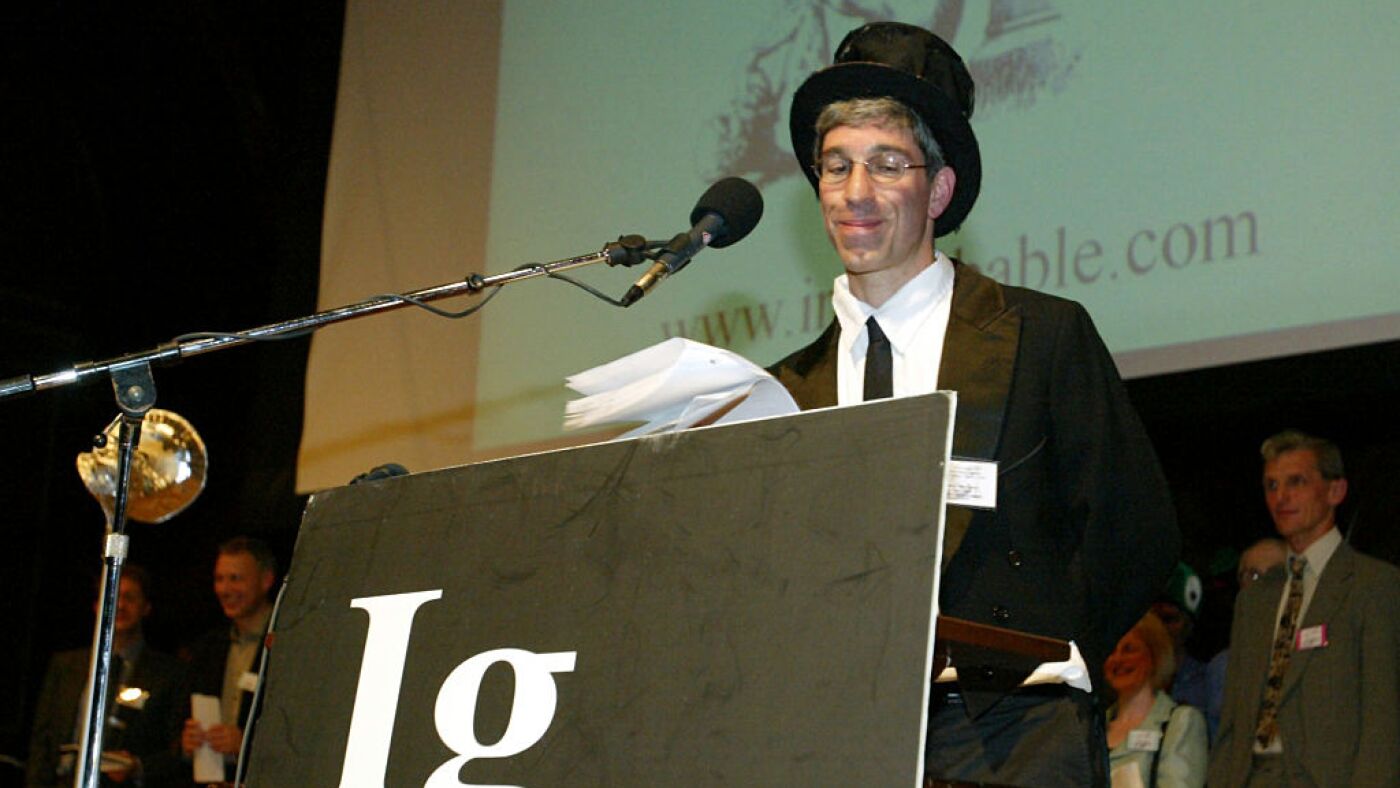Master of Ceremonies Marc Abrahams addresses the audience during a pre-pandemic Ig Nobel Prize ceremony.
Rick Friedman/Corbis via Getty Images
hide caption
toggle caption
Rick Friedman/Corbis via Getty Images
It was the quirky aspects of science that researchers celebrated at this year’s Ig Nobel award ceremony at the Massachusetts Institute of Technology in Cambridge, Mass. Actual Nobel laureates gave out the ten prizes.
“This is the first in-person, with everyone together in one room, ceremony we’ve done since before the pandemic,” says Marc Abrahams, the founder and organizer of Ig Nobel event and editor of the Annals of Improbable Research.
On Thursday night, Abrahams stood before a packed audience in one of MIT’s largest lecture halls. “We honor some remarkable individuals and groups,” he said. “Every Ig Nobel prize winner has done something that first makes people laugh, and then makes them think.”
Plants that see
“I feel my research fits really well on this prize because I receive a lot of critiques about the paper,” says Felipe Yamashita with a chuckle, a botanist and one of the award winners.
He has a somewhat alternative view of plants. “I believe that plant[s] can see,” he asserts. “I don’t know how they can see. They don’t have an eye, but I’m pretty sure they can understand what’s going [on].”
Yamashita just finished his Ph.D. in botany at the University of Bonn. His thesis focused on a kind of plant called Boquila trifoliolata found in the temperate rainforests of southern Chile and Argentina. A decade ago, a paper came out saying that B. trifoliolata can change its lobed or rounded leaf shape to mimic the leaf shape of other plants.
Those authors speculated it was due to chemicals or microbes, but Yamashita and his collaborator had their doubts. “We didn’t really agree with that,” he says. “Then we said, ‘OK, let’s do another experiment [that] prove[s] that maybe [the plants] have some vision.’ ”
Yamashita’s experiment was simple. He grew several of the plants on a trellis divided by a couple shelves. These opaque barriers blocked the lower part of the plant from the upper part. Along the top of the trellis, Yamashita wove an plastic plant with slender, unlobed leaves. The artificial plants didn’t have the chemicals or microbes that might trigger the shape mimicry response.
When the real plant grew, the leaves below the shelves were lobed. But “almost all leaves that were growing close to the plastic leaf copied the plastic leaf shape,” says Yamashita. That is, the mimic leaves were longer, and less lobed.
Yamashita thinks the real leaves sensed the shape of the plastic leaves by detecting where they were letting light through and where they weren’t. “So the leaf grow one way, not the other way,” he says. “One direction, not the other direction.”
It’s a kind of seeing, concludes Yamashita. He says it may function as camouflage to help the plant blend in with its neighbors to reduce being munched on by some herbivore. The results were published in the journal Plant Signaling & Behavior.
A myth of old age
Another Ig Nobel recipient is Saul Justin Newman, an interdisciplinary scientist at Oxford University.
“I was joking to my family,” he recalls. “Every scientist dreams of the Nobel, but my dream had a typo and I’m perfectly happy.”
Newman snagged his award for his research showing that data related to some of the longest-lived people on the planet is riddled with errors.
“For example, the world’s oldest man has three birthdays, one of which seems to be a deliberate fraud.” he says. “In Japan, 82% of the 100-year-olds turned out to be alive on paper — and dead in reality.”
The list goes on. “I had a lady reach 103 in a freezer,” says Newman.
He admits at first, these results sound kind of humorous. But there’s something pernicious going on.
“Picture your father dies or your mother dies at the age of 95,” he explains. “You’ve got no job and their pension check turns up the week after they’re dead. All you have to do for that pension check to keep turning up in perpetuity is not register the death.”
Newman says it’s easy to get away with. And he’s found a link between people who reach remarkable ages on paper and places in the world where there’s a hefty amount of pension fraud.
“It’s dissonant because all of these places don’t rank very highly on any other metric of survival,” he says.
Other Ig Nobel winners this year included a prize for the study of the swimming ability of dead trout. Another demonstrated a technique for separating drunk worms from sober ones.
Abrahams closed the award ceremony with these words:
“If you didn’t win an Ig Nobel Prize tonight — and especially if you did — better luck next year.”
